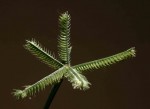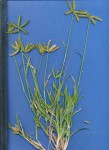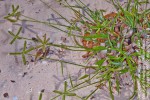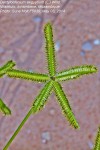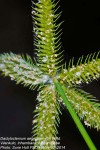| Home | > | List of families | > | Poaceae | > | Dactyloctenium | > | aegyptium |
Dactyloctenium aegyptium
Selected images: Click on each image to see a larger version and details of the record View all images (7)
Detailed records: Display species records QDS maps by: Google Maps Point records by Google Maps
Species details: Click on each item to see an explanation of that item (Note: opens a new window)
| Synonyms: |
Cynosurus aegyptius L. Dactyloctenium mpuetensis De Wild. |
| Common names: | Common crowfoot (English) Helicopter grass (English) |
| Frequency: | |
| Status: | Native |
| Description: |
Slender to moderately robust spreading annual; culms up to 70(100) cm tall, usually geniculately ascending and rooting from the lower nodes, often shortly stoloniferous and mat-forming, less often erect; leaf laminas 3–25 cm × 2.5–7.5(12) mm, flat, papillose-hispid especially along the margins.Racemes (1)3–9, 1.2–6.75 cm long, linear to narrowly oblong, ascending or radiating.Spikelets 3.5–4.5 mm long, broadly ovate, 3–4-flowered; glumes subequal, 1.5–2.2 mm long, the inferior lanceolate in profile with a thick scabrid keel, the superior elliptic to narrowly obovate in profile, the smooth keel extended into a stout divergent scabrid awn 0.5–2 times as long as the body; lemmas 2.6–4 mm long, narrowly ovate to ovate in profile, the keels gibbous, concave and scabrid above the middle and often extended into a stout cusp or mucro up to 1 mm long; palea keels winged or wingless; anthers 0.25–0.8 mm long.Caryopsis c. 1 mm long, broadly obovate to obtriangular, transversely rugose. |
| Type location: |
|
| Notes: | Spreading annual grass, rooting from the knee-bent lower nodes. Inflorescences digitate, often in thick radiating racemes with bristly spikelets. |
| Derivation of specific name: | aegyptium: of Egypt |
| Habitat: | A species of wooded grassland and riverine thickets, often along roadsides and sandy soils. Also found as a weed of cultivation and fallow lands. |
| Altitude range: (metres) | Up to 1600 m |
| Flowering time: | Jan - Apr |
| Worldwide distribution: | Tropical and warm-temperate regions of the Old World; introduced weed in America and Europe |
| National distribution: | N,T,MS,GI,M |
| Growth form(s): | |
| Endemic status: | |
| Red data list status: | |
| Insects associated with this species: | |
| Spot characters: | Display spot characters for this species |
| Images last updated: | Friday 25 July 2014 |
| Literature: |
Chapano, C. & Mamuto, M. (2003). Plants of the Chimanimani District National Herbarium and Botanic Garden, Zimbabwe Page 20. Chapano, C. & Mugarisanwa, N.H. (2003). Plants of the Matobo District National Herbarium and Botanic Garden, Zimbabwe Page 13. Cope, T.A. (1999). Poaceae Flora Zambesiaca 10(2) Pages 163 - 165. (Includes a picture). Heath, A. & Heath, R. (2009). Field Guide to the Plants of Northern Botswana including the Okavango Delta Kew Publishing Page 449. (Includes a picture). Isaiah, A.M. & Komi, T. (2015). Grasses in the Botswana National Botanic Garden South African National Biodiversity Institute, Pretoria Page 11. (Includes a picture). Jackson, G. & Wiehe, P.O. (1958). An Annotated Check List of Nyasaland Grasses The Government Printer, Zomba, Nyasaland Page 34. As Dactyloctenium aegypticum Mapaura, A. & Timberlake, J. (eds) (2004). A checklist of Zimbabwean vascular plants Southern African Botanical Diversity Network Report No. 33 Sabonet, Pretoria and Harare Page 102. Roodt, V. (2015). Grasses & Grazers of Botswana and the surrounding savanna Struik Nature, South Africa Page 76. Setshogo, M.P. (2005). Preliminary checklist of the plants of Botswana. Sabonet Report no. 37. Sabonet, Pretoria and Gaborone Page 134. Siebert, S. & Mössmer, M. (Editors) (2002). SABONET Southern Mozambique Expedition 2001; Provisional Plant Checklist of the Maputo Elephant Reserve (MER) and Licuati Forest Reserve (LFR) SABONET News 7(1) Page 27. Timberlake, J.R. & Childes, S.L. (2004). Biodiversity of the Four Corners Area: Technical Reviews Volume Two (Chapter 5-15) Appendix 5-1: Plant Checklist Occasional Publications in Biodiversity 15 Page 188. |
Other sources of information about Dactyloctenium aegyptium:
Our websites:
Flora of Botswana: Dactyloctenium aegyptiumFlora of Burundi: Dactyloctenium aegyptium
Flora of Caprivi: Dactyloctenium aegyptium
Flora of Malawi: Dactyloctenium aegyptium
Flora of Zambia: Dactyloctenium aegyptium
Flora of Zimbabwe: Dactyloctenium aegyptium
External websites:
African Plants: A Photo Guide (Senckenberg): Dactyloctenium aegyptiumAfrican Plant Database: Dactyloctenium aegyptium
BHL (Biodiversity Heritage Library): Dactyloctenium aegyptium
EOL (Encyclopedia of Life): Dactyloctenium aegyptium
GBIF (Global Biodiversity Information Facility): Dactyloctenium aegyptium
Google: Web - Images - Scholar
iNaturalist: Dactyloctenium aegyptium
IPNI (International Plant Names Index): Dactyloctenium aegyptium
JSTOR Plant Science: Dactyloctenium aegyptium
Mansfeld World Database of Agricultural and Horticultural Crops: Dactyloctenium aegyptium
Plants of the World Online: Dactyloctenium aegyptium
Tropicos: Dactyloctenium aegyptium
Wikipedia: Dactyloctenium aegyptium
| Home | > | List of families | > | Poaceae | > | Dactyloctenium | > | aegyptium |
